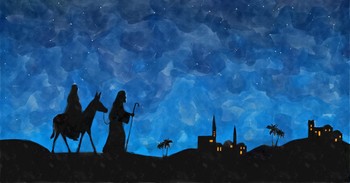Writing about two women in the Bible whose names I have glossed over in reading the word on several occasions, I realize that the Bible is truly living and active and sharper than any two-edged sword. I’m not sure that many are familiar with the two women named Adah. Still, the Bible’s stories come alive once we mine for more information, including historical and cultural context. We find both women in the book of Genesis, and while their claim to biblical fame is as a wife and mother, they are named, and therefore, God intends for us to understand how their stories fit into God’s great Story.
What Does the Name Adah Mean?
First, I think it’s interesting that the definition of Adah is “ornament.” Since both women are listed in the context of being someone’s wife, we in the twenty-first-century may take offense at the literal use of the word—as if these women were nothing but adornments for their husbands. Certainly, we know better that in that time, women’s lives were much more difficult than today unless they had a great deal of money and servants.
However, the Shalvi/Hyman Encyclopedia of Jewish Women says, “The name Adah, in signifying aesthetic qualities, is common in the ancient Semitic world and may point to the fact that female beauty was deemed important.” So perhaps these women were chosen and prized for their beauty, which may also have to do with the children they would bear (the hope of beautiful daughters to make fruitful matches?)
What Do We Know about Adah, Wife of Lamech?
Understanding these two helps to return to a story that may be more familiar.
Cain and Abel were the sons of Adam and Eve, and Cain killed Abel out of jealousy. After God tells him his punishment is to be a restless wanderer on the Earth, Cain “lay with his wife and gave birth to Enoch” (Genesis 4:17).
Four generations later, Lamech was born. Between Adam and Lamech, there were seven generations–always a significant number in the Bible, so perhaps that’s why what follows is an exposition of Lamech’s life. We learn that Lamech married two women, Adah and Zillah. There is no mention of where these women came from since this is just the seventh generation of people on earth, but it would be safe to say that these women were related somehow to Lamech.
What Did Adah and Lamech’s Child Become Known For?
Genesis 4:20-22 tells us that Adah gave birth to Jabal; he was the father of those who live in tents and raise livestock. His brother’s name was Jubal; he was the father of all who play the harp and flute. Zillah had a son named Tubal-Cain, who forged tools out of bronze and iron.
Shalvi/Hyman points out what may not be so evident to the 21st-century reader: these sons “are the founders of the civilized arts, which are thus presented as a fully human product [project] and not as a gift of the gods, as in many mythological beginnings stories of other cultures.” In other words, the One True God gave these three the ability to organize, create, invent, and build. He didn’t give them the finished product.
Therefore, the line of Adah’s son sounds like the first herder and nomad tribe who would have had to travel to keep finding food for the livestock. In previous generations, we don’t read anything except that Cain was building a city, implying that people were living together and were doing little traveling.
What Do We Know about Adah, Wife of Esau?
There was another Adah who married a prominent man in the line of God’s chosen people. Further in Genesis, we read about God’s covenant with Abraham—that God had chosen Abraham as the man through whose lineage the whole world would be blessed. When it’s time for his son Isaac to marry, his father does not want someone outside their “family” to be his wife (like a local pagan Canaanite woman). Isaac marries Rebekah, his first cousin, and she bears twin sons, Esau and Jacob.
As the older, Esau would be the owner of the birthright when his father died, making him head of the clan, who would receive a double portion of the inheritance. Jacob ends up stealing the birthright (actually, Esau, in his ravenous, impetuous hunger, gives up his birthright) with his mother’s assistance. Esau was beyond livid and threatened to kill Jacob. Their mother suggested Jacob get out of town and live with relatives for a while. It would be a while before his father Isaac’s death and his claim to the stolen birthright, but he would be safe from his brother with his Uncle Laban, his mother’s brother.
What does all of this have to do with a woman named Adah? As Jacob marries and has children, so does Esau. But the difference is that Rebekah sent Jacob to her family to find a wife for him from within their clan (Uncle Laban’s daughters). Esau instead took his wives from the land of Canaan, including Adah, the daughter of Elon the Hittite.
According to the World History Encyclopedia, the Hittites “were the descendants of Heth, son of Canaan, who was the son of Ham, born of Noah” (Gen 10:1-6).
Interestingly, the International Standard Bible Encyclopedia says that some names of the Hittites in Genesis, including Adah, were Semitic. So, whether or not Adah has Semite blood in her background is difficult to determine. Nevertheless, as far as Esau’s parents were concerned, she was a pagan woman, and his marriage to her drove a wedge between them and Esau. Starting with Abraham (and by God’s order?) God’s chosen people were not to intermarry with the people of Canaan. Therefore, Esau and his family were cut off from the blessings of God, whose covenant was made with the people of Israel.
After 20 years, Jacob leaves Laban, bringing along his wives, children, animals, and belongings, and starts heading toward Edom to encounter Esau for the first time in that many years. Jacob sends messengers ahead to see if the greeting will be friendly and finds out that Esau is coming toward him with 400 of his men. When they finally meet, Jacob is terrified, but “Esau ran to meet Jacob and embraced him: he threw his arms around his neck and kissed him and they wept.” (Gen 33:4-5). They separated again, with Esau, Adah, and his other wives and children heading back to the land of the Edomites. Jacob headed back to familiar Canaan.
What Did Adah and Esau’s Children Become Known For?
Adah only bore one child to Esau: a male named Eliphaz. He had many children through his other wives, and the children were fruitful and multiplied. Esau’s sons began to be called “chiefs,” and the next generation became the first kings who reigned in Edom “before any Israelite king.”
Interestingly, they became known as Edomites because both Esau and Edom mean “red.” When Esau was born, he was said to have red skin, so he was also called Edom in his later years as he built his own people group. When the Edomites would encounter Israelites in later years, the ISBE notes that “Israel was forbidden to "abhor an Edomite," on the ground that he was a brother; and children of the third generation might enter the assembly of the Lord (Deuteronomy 23:7).
But later, we read of a war between the Israelites and Edomites during King Saul’s rule, and the Edomites were slaughtered. We read more of Edom’s exploits in 1 and 2 Kings—the ISBE reports that Edom revolted again years later, attacking the son of Jehosophat (the fourth king of Judah). When King Nebuchadnezzar invaded the land of Judah in 605 BC, the Edomites lent their assistance to the king and then settled in some of the land of Judah that was now unoccupied.
Photo Credit: ©GettyImages/kieferpix
Mary Oelerich-Meyer is a Chicago-area freelance writer and copy editor who prayed for years for a way to write about and for the Lord. She spent 20 years writing for area healthcare organizations, interviewing doctors and clinical professionals and writing more than 1,500 articles in addition to marketing collateral materials. Important work, but not what she felt called to do. She is grateful for any opportunity to share the Lord in her writing and editing, believing that life is too short to write about anything else. Previously she served as Marketing Communications Director for a large healthcare system. She holds a B.A. in International Business and Marketing from Cornell College (the original Cornell!) When not researching or writing, she loves to spend time with her writer daughter, granddaughter, rescue doggie and husband (not always in that order).
This article is part of our People of Christianity catalog that features the stories, meaning, and significance of well-known people from the Bible and history. Here are some of the most popular articles for knowing important figures in Christianity:
How Did the Apostle Paul Die?
Who are the Nicolaitans in Revelation?
Who Was Deborah in the Bible?
Who Was Moses in the Bible?
King Solomon's Story in the Bible
Who Was Lot's Wife in the Bible?
Who Was Jezebel in the Bible?
Who Was the Prodigal Son?




